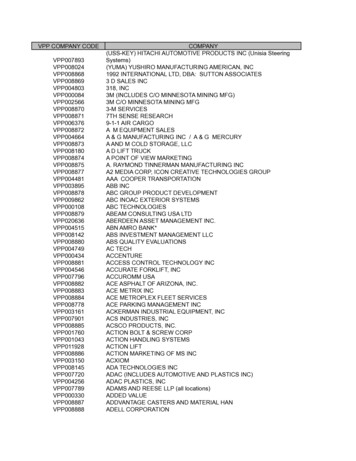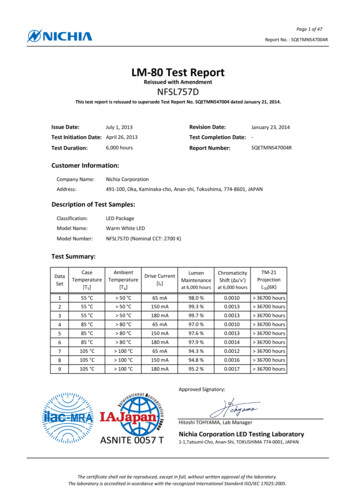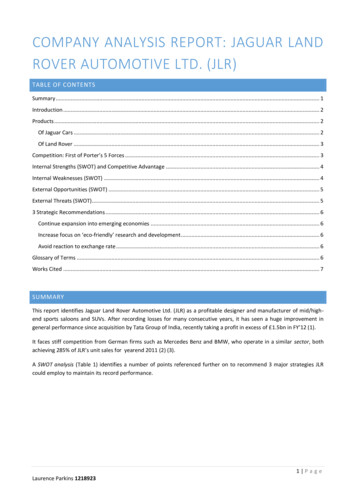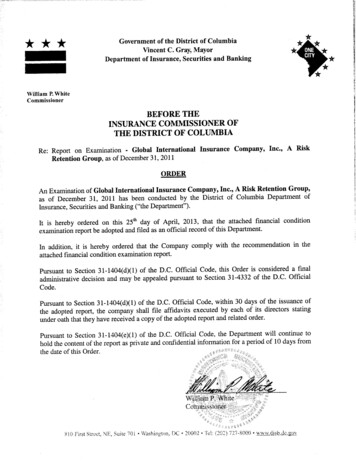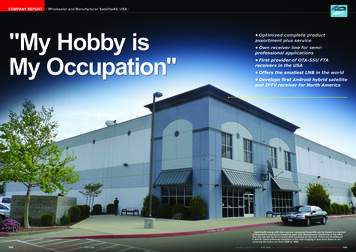
Transcription
COMPANY REPORTWholesaler and Manufacturer SatelliteAV, USA"My Hobby isMy Occupation" Optimized complete productassortment plus service Own receiver line for semiprofessional applications First provider of OTA-SSU FTAreceivers in the USA Offers the smallest LNB in the world Develops first Android hybrid satelliteand IPTV receiver for North America SatelliteAV along with their partner company PowerON can be found in a sectionof Roseville’s enormous industrial park near Sacramento, California in the USA.You can see the tip of a C-band dish mounted on the roof. There are 10 differentC and Ku band antennas installed on the roof ranging in size from 45cm to 3mcovering the entire arc from 58W to 166E.194 TELE-satellite International — The World‘s Largest Digital TV Trade Magazine — 12-01/2012 — www.TELE-satellite.comwww.TELE-satellite.com — 12-01/2012 —TELE-satellite International — The World‘s Largest Digital TV Trade Magazine195
COMPANY REPORTWholesaler and Manufacturer SatelliteAV, USASuccess with YourHobby – Plus aLittle LuckëSacramento Brian Gohl isFounder and Presidentof SatelliteAV. Thecompany distributesthe GLORYSTAR systemand as a wholesalermanufactures anddistributes theGEOSATpro brand name.196 TELE-satellite International — The World‘s Largest Digital TV Trade Magazine — 12-01/2012 — www.TELE-satellite.com
Megan Paradise is the Call CenterTeam Leader. She coordinates theincoming telephone calls fromcustomers with her seven employees.“We also all have a technicalbackground and can therefore answerany technical questions”, says MeganParadise pointing out that theseemployees are all highly qualified.Sure enough, Brian Gohl packed histhings and moved to Sacramento innorthern California. Satellite AV tookover a portion of the PowerON warehouse and offices with new partner,Brent Kelley as CEO and a short timelater brought on Kevin Hardy, CFO.PowerON had something that SatelliteAV was missing: enormous technicalexpertise and an expansive Call Centerinfrastructure.The best career you could possiblyhave is one in which you turn your hobby into your occupation and you’re actually excited to go to work every day.Or, as Brian Gohl puts it, “On the weekend I can’t wait for the start of workMonday morning.”Brian Gohl took his hobby – the playing around and experimenting with satellite components – and turned it intothe successful company SatelliteAV.But the path to this success was notexactly a straight line, in fact the initial spark was actually a catastrophe:“I was struck by a bolt of lightning thatput me in the hospital for three monthsand since then I’ve had a pacemaker”,explains Brian Gohl coolly regarding hisworst experience. Bonnie Marroquin coordinatesthe cooperation with broadcastersand assigns each of them their owntelephone number. She explains, “Atthe moment we operate 85 toll-freenumbers and receive on average 200telephone calls every day.”Brian Gohl started his career with acompany that offered data transmissions via satellite. That was 1984 in FortLauderdale, Florida and the technologybehind this was still in its infant stages.Back then only large companies couldafford satellite transmissions. BrianGohl was responsible for the send andreceive sections. One day a techniciancalled in sick and Brian Gohl was askedto swap out an amplifier at a receptionstation. At that very moment, as he unscrewed the component, a lightning boltstruck the station sending him severalmeters across the floor. He went to thehospital and had a pacemaker implanted. Unfortunately, this meant he couldno longer work at his job since the powerful transmissions from satellite stations could disrupt his pacemaker.Brian Gohl changed jobs but stayedclose to the technology: he became acameraman and worked for severalyears in TV production. His first satelliteTV system he had already installed byhis father back in 1983. In 1989 he feltthe time was right and moved to Oregonand for the first time had enough spaceto erect his own satellite system: “It wasa three-meter C-band dish that I expanded to include the Ku-band in 1992”,remembers Brian Gohl. As fate wouldhave it, his mother came to him one daywith a problem. At that time she livedin Washington State but in a valley faraway from everything. She was so faraway that she couldn’t receive any TVsignals. Brian Gohl installed a 1.8-metersatellite antenna so that she could receive 3ABN, a Christian oriented channel. His mother was so thrilled that shetold the story all over town. That’s howBrian Gohl began installing more satellite systems on the weekends.Now SatelliteAV entered a new business sector: the company began offering satellite reception systems forChristian channels under the nameGLORYSTAR. The reality is that all ofthe different Christian channel operators don’t want to or are unable to devote staffing and resources to supportthe distribution, installation and technical support of FTA systems, but on theother hand are dependent on their future customers successfully setting upand then maintaining a satellite reception system.Brian Gohl explains the procedure likethis: “The Christian channels advertiseusing every possible local media outlet.These ads direct potential customersto call a specific telephone number toorder a satellite system so that thesepeople can watch their TV channel.”Since GLORYSTAR offers this service tonearly every Christian TV provider, allof these telephone calls, regardless ofwhat number is actually dialed by theend-users, end up in SatelliteAV’s CallCenter. “Depending on the programming operator, our employees answerusing that providers name”, explainsBrian Gohl. The driving force of theoperation is Office ManagerJanine Mullinix. She concernsherself with the smooth flow ofthe office.As the demand for his satellite installation work continued to increase a decision had to be made between TV production and satellites. The love of thesatellite hobby won out and in 2001 hefounded Satellite AV. “In the first several years I sold and installed more than300 complete systems a year”, says Brian Gohl as he looks back at the beginning.At this point Brian Gohl’s hobby activities come fully into play: the customersthat want to receive these TV channelsget not just a typical satellite receiversystem that you can buy almost anywhere, but rather a special systemspecifically designed for Christian TVchannels. “We offer a special satellitereceiver that can be operated in twodifferent modes”, explains Brian Gohl,“either in normal mode like any otherreceiver or you activate the GLORYSTARprogramming. In this second mode, themenu is greatly simplified since theChristian channels and transpondersare already preprogrammed. The customer really can’t do anything wrong.”The leap from a one-man operation toa real company came at an Easter family reunion. One of his relatives, BrentKelley, operated the company PowerON(www.poweron.com) with an interestingbusiness concept: They purchase usedelectronics (mostly higher valued PCs,laptops, monitors and Smartphones)refurbish them and then resell themeither directly or through middlemen.Some devices such as Smartphonesare disassembled and usable components such as the flash memory and thescreen are picked out of the pieces. Atthat Easter meeting the idea to combinethe expertise of PowerON with BrianGohl’s satellite firm was discussed.198 TELE-satellite International — The World‘s Largest Digital TV Trade Magazine — 12-01/2012 — www.TELE-satellite.com Nothing functions withoutbookkeeping. Senior Accountant HopeLothrop organizes all of the invoicesand keeps an eye out on all companyexpenditures.www.TELE-satellite.com — 12-01/2012 —TELE-satellite International — The World‘s Largest Digital TV Trade Magazine199
The GEOSATpro receiver was the firstFTA product in the USA to introduce automatic receiver programming via satellite. All GEOSATpro receivers are keptup-to-date via two satellite streams:one stream is used to keep the firmwareupdated while the second stream keepsthe channel programming current.“When we started with this system in2006, we coordinated with 18 channelsfrom 10 different Christian providers. In2011 it’s grown to 67 channels from 45providers”, explains Brian Gohl.SatelliteAV’s success is actually greater if you analyze the situation in the USAa little closer. For satellite viewers inNorth America there are only three areas where they can watch free TV: thefirst would be foreign language channels for all the different ethnic groups.For English-language viewers that is irrelevant; all that remains for them arethe religious oriented channels thatdon’t encrypt their programming. Thethird group of freely receivable channels would be feed transmissions although this is more for satellite enthusiasts who have a motorized antenna aswell as some necessary patience. As asatellite enthusiast himself, Brian Gohlis in the process of developing something for that segment, but more onthat later.In just a few years Brian Gohl, withhis GLORYSTAR system and the knowhow and organizational expertise ofhis partner PowerON, has won over avery important group of FTA viewers inNorth America. “We are working witha partner in Canada and in Mexico ourbranch office there is run by JonathanMcCallie”, comments Brian Gohl on theactivities of these groups. Jonathan McCallie came up with the name GLORY-STAR. “Today we have 15 employeesthat work for GLORYSTAR as well as twoemployees in Mexico”, comments BrianGohl.How successful is GLORYSTAR in thesales of their satellite systems? “In 2005we sold roughly 5,500 complete systems. That number increased to 10,000in 2011 and for 2012 we’re expecting afurther increase of 15%”, reveals BrianGohl and then continues, “SatelliteAV,as a manufacturer and wholesaler,sold an additional 1000 complete systems, 5000 receivers and 20,000 LNBFsthrough their reseller network in 2005.Those numbers remained relativelyconstant over the years and for 2012we’re expecting an increase.”Let’s turn away from GLORYSTAR’sactivities and have a look at what wholesaler and manufacturer SatelliteAV hasto offer: “In 2005 we founded a newbrandname, GEOSATpro, under whichwe offer C-band, Ku-band and C/Kuband LNBs, installation kits and satellitedishes ranging in size from 90cm to 2.4meters.” In 2007 SatelliteAV expandedits receiver production. “In 2007 we introduced the first PVR SD receiver tothe North American market that in 2009was expanded to include automatic programming via satellite. This was also afirst for the North American market”,reports Brian Gohl proudly on his company’s innovations.Other innovative creations from BrianGohl, the satellite enthusiast that consistently works on new ideas, include amast insert with built-in bubble level, aKu-band LNB bracket for two LNBs offset by 4 that is so flexible that it can beused anywhere in the USA plus an especially interesting highlight: “We offerthe world’s smallest LNB!” explains Brian Gohl referring to the 40mm narrowLNB that is the same size as the LNBbracket thus allowing two of these LNBsto be mounted right next to each other.“They are not only extremely small, butalso extremely sensitive across the entire frequency spectrum”, commentsBrian Gohl.With this LNB he has locked himselfinto a small but nice market segment.“These LNBs are ideally matched to our90cm dish; the built-in feed of the LNB Customer reported problems can bedealt with here as can the testing of newsoftware versions. Technical ManagerEugene Zaikin is seen here testing thecorrect function of a receiver.200 TELE-satellite International — The World‘s Largest Digital TV Trade Magazine — 12-01/2012 — www.TELE-satellite.com
SATELLITEAVWholesaler and Manufacturer, USAwww.satelliteav.comCompany DetailsEngineers in Research & Development Total Number of Employees 0. 10 . 20Average Turnover (Previous, This, Next Year Estimates) 0. 2.5 . 5 Mio U D123Production CertificatesDVBwas specifically designed without thetraditional external scalars and therebyoptimally illuminates our dish.”Production Categoriesown brands GEOSATpro, GLORYSTARMain ProductsComplete Satellite Systems GLORYSTAR, accessories, LNBs,19“ satellite receiversand the new Android 2.3 version there’sno longer anything standing in the wayof their use in receivers”, Brian Gohl 1109/eng/satelliteav.pdfBrian Gohl’s love for detail and hisself-proclamation as a satellite enthusiast has brought about another product series: semi-professional satellitereceivers for 19-inch racks. They caneach receive only one channel that isnot only very stable but with audio andvideo outputs that professionals demand such as symmetrical audio jacks.His heart for the third group of freelyreceivable channels, the feed huntersthat we mentioned earlier, will be happywith Brian Gohl’s latest development forhis line of rack mounted receivers: “Ournewest rack model will come with notonly an ASI output but also a USB portfor PVR and an HDMI output. Aboveall, we also offer MPEG 4:2:2 with thisrack model for feed reception as well asBlind Scan and an extremely wide rangeof symbolrates from less than 1.0 Ms/sec all the way up to 45.000 Ms/sec.”Brian Gohl saved the best for last: “Thisrack model will sell for less than US 500.00.”4Brian Gohl started off with a smallcompany but turned it into a large firmwith a wide assortment of services. Withhis new product creativity he’s able tolook into the future and expand his operation to customers outside of NorthAmerica. SatelliteAV is on the road tobecoming a global player.Yet, Brian Gohl still hasn’t reachedhis creative limit: “We are currently inthe process of developing an Androidbased hybrid box that will be set up forHDTV reception via satellite and IPTV.”Brian Gohl believes that Internet TVis the future for the long term and heis very enthusiastic about the Androidoperating system. “There are so manyapplications already available for thisoperating system and because of thisit will be the leader.” The fact that Android has not prevailed as of yet lies upuntil now, according to Brian, with theslow processor speeds. “With new chips202 TELE-satellite International — The World‘s Largest Digital TV Trade Magazine — 12-01/2012 — www.TELE-satellite.com5www.TELE-satellite.com — 12-01/2012 —1. Satellites Receivers as far as theeye can see: palette after palette inSatelliteAV’s large warehouse.2. This is how a dish with all of itsmounting hardware is packed. “I needroughly 1:30 minutes to pack a dishwith all of its components”, explainsArmando Rocozco. 1200 of thesecomplete systems are currently beingshipped every month.3. Brian Gohl thought of everythingwhen he put together the dish antennapackage. In addition to the necessaryparts that come with each package,such as prefabricated coax cable,you’ll also find things like a compassand grounding clips. He even thoughtof including a sealing kit for thecable connections. Also included isa customized printout of azimuth andelevation values (left side of picture)based on the customer’s zip code orpostal code.4. Armando Aorozco works in thewarehouse and is also responsible forpackaging the dish antennas; all ofthe dish components are delivered toSatelliteAV separately. “It’s more costeffective than having the manufacturerin Asia package them completely andship them”, says SatelliteAV FounderBrian Gohl.5. Shipping Manager Rupi Khangurakeeps an eye on things in thewarehouse. He not only oversees andorganizes shipping within the USAbut also incoming shipments fromproduction facilities in Asia. “Onepalette contains 138 90cm dishes”, hesays.TELE-satellite International — The World‘s Largest Digital TV Trade Magazine203
Innovative Productsfrom SatelliteAV11. A Brian Gohl invention: an antenna mountwith fully adjustable mast leveling on allaxis plus built-in spirit level. “If the bubble isdirectly in the middle, the mast is perfectlyvertical”, comments Brian Gohl regarding hisinvention that is flexible up to 30 in everydirection. The antenna mount can therefore beinstalled on uneven or slightly angled surfaces.2. The smallest LNBF in the world! At 40mmthey are the same size as the mounting bracketand can therefore be mounted right next toeach other as can be seen here in a Brian Gohldesigned mount for two satellites with a 4 offset (installed on a 90cm dish). The multisatellite rotating LNBF clamp is designed insuch a way that LNBFs can be independentlypositioned as much as necessary in order tooptimize each LNBF for the antenna's focalpoint for each satellite. The LNBFs to the leftare narrow but normal in length while theLNBF to the upper right is shorter and thus thesmallest consumer Ku band LNBF in the world.A universal version of this LNBF is currentlysold in several European Markets and isavailable for OEM production.3. Although normally very hard to get, atSatelliteAV they are part of the standardproduct line: Ku-band LNBs for prime focusdishes. They would be used, for example, withan existing C-band dish that is being convertedto Ku-band use. Normal Ku-band LNBs aredesigned for offset dishes and are thereforenot meant for prime focus antennas.4. Semi-professional 19-inch rack mountedsatellite receivers are supplied by SatelliteAVunder the brand name GEOSATpro. Theycome with audio and video outputs desired byprofessionals but are far less expensive thanprofessional rack mounted receivers.234204 TELE-satellite International — The World‘s Largest Digital TV Trade Magazine — 12-01/2012 — www.TELE-satellite.com
196 TELE-satellite International — The World‘s Largest Digital TV Trade Magazine — 12-01/2012 — www.TELE-satellite.com Success with Your Hobby – Plus a Little Luck Brian Gohl is Founder and President of SatelliteAV. The company distributes the GLORYSTAR system and as a wholesal
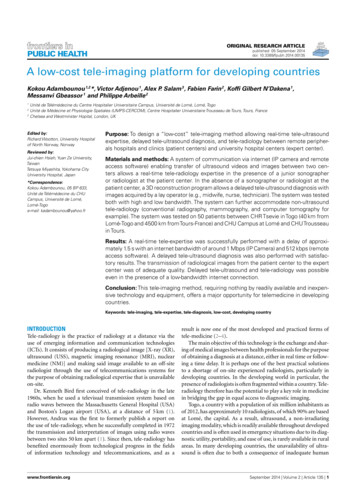


![Shareholders’ Agreement of [Company name] company. 1 .](/img/1/startup-founders-sha-sample.jpg)
